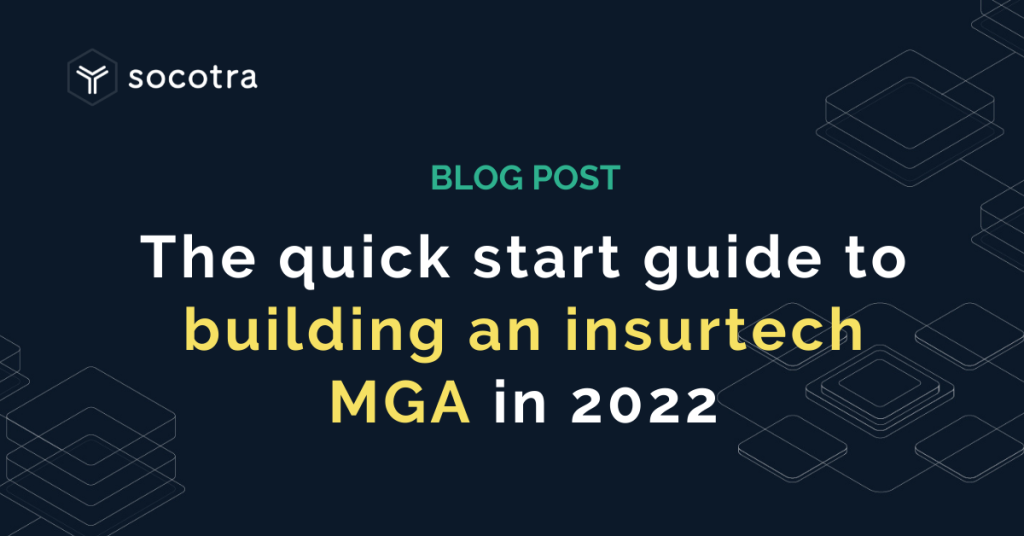The quick start guide to building an insurtech MGA in 2022

Insurers today have access to more data than ever before, enabling them to improve risk assessment, reach untapped markets, and deliver outstanding customer experiences. As a result, a new class of tech-driven managing general agents (MGAs) is emerging, blazing trails and building innovative products for underserved customers.
The founders of these emerging MGAs may come from various backgrounds, but what they have in common is the understanding that technology is the key to unlocking these fresh opportunities. Building any new business from scratch, however, comes with its fair share of challenges . That’s why we’ve come up with three key steps to put you on the right path to bringing your insurtech MGA from concept to launch.
Step 1: Develop a business strategy that differentiates your rating, underwriting, and distribution
Many MGA founders get into the insurance industry because they’ve found a gap in the market or an underserved niche. As a founder, the first thing you should do to validate the economic feasibility of this opportunity is to conduct extensive research on the target customer and their preferences, and assess the total size of the addressable market. If you’re considering selling a product that already exists in the market, figure out how it’ll be better than the competitors. If you’re pursuing an entirely new category of products, get a sense of the market demand by conducting customer interviews.
Once you’ve developed a stronger understanding of who your customers are and what they need, it’s time to draw up a business plan. Investors and carriers will look to this business plan before committing, often focusing on the rating model and distribution strategy.
- Rating and underwriting. Insurers now have access to a wealth of data sources and predictive models that allow them to improve risk assessment and deliver more personalized pricing to their customers. They’re also using technology to automate the underwriting process with straight-through-processes that help reduce customer acquisition costs. Consider how your MGA can personalize pricing and coverage or lower premiums for customers.
- Distribution. Today’s customers expect the convenience and ease of buying insurance through a website or app. MGAs are responding by offering insurance products through digital distribution channels or even embedding them at the point of sale for third-party products. Think about how you’ll give customers easier access to insurance coverage and reduce friction in the buying process. Would your product fare better if an independent retail agent could sell it to their existing clientele? If so, how will you attract, train, and engage with those independent agents? Defining your strategy for distribution is the first step to attracting key investor and carrier relationships you’ll need in order to be successful.
Remember that it takes time to develop a business plan, and you’ll likely go through multiple iterations before locking in a truly unique value proposition.
Step 2: Define your technology strategy and find a partner that makes it fast and affordable to launch, iterate, and integrate your products
The core platform is arguably the most important piece of an MGA’s tech stack, acting as a central hub that connects mission-critical policyholder data to third-party data sources and distribution channels. MGA founders must decide whether they should build a new platform or leverage an existing one to handle core underwriting, policy administration, billing, claims, and reporting functionality.
This decision will also impact your overall technology and go-to-market strategies. For example, if your distribution strategy requires you to offer highly personalized customer experiences, then it may make more sense to purchase a SaaS core platform so your IT resources are not spread too thin. Many founders choose to keep their operations lean in the beginning, which means prioritizing your limited resources where you’ll have the best chance of success.
Building your own platform offers greater control, but it has drawbacks in terms of speed-to-market, cost, business focus, and long-term features and upgrades. A modern, out-of-the-box core platform is the faster, easier, and more cost efficient option.
When choosing a core platform, beware of common traps and red flags and focus on looking for:
- Flexible integrations and distribution channels. High-growth MGAs often differentiate their insurance products by leveraging technology to improve risk assessment, underwriting, and distribution. Look for a core platform that can seamlessly integrate with third-party data sources and enable omnichannel interactions, whether it’s on a mobile app, over-the-phone, or with an agent.
- Accelerated speed-to-market. For startups, getting your product to market quickly is essential. The faster you launch, the sooner you can lower your cash burn rate, test and iterate a live product, and begin the process of raising additional capital. That’s why it’s important to find a technology vendor that can accelerate speed-to-market with flexible implementation approaches, publicly-available documentation, and intuitive APIs.
- Lower total cost of ownership. When comparing platforms, pay attention to implementation timelines and how many in-house developers are required to deploy each platform, which significantly impacts costs. Most platforms charge millions of dollars in maintenance and upgrades fees, but a cloud-native core platform will provide upgrades for free.
- Rapid product iteration. MGAs need to deliver exceptional pricing and experiences to win over customers, which requires a core platform that can make product iteration and optimization fast and easy. With legacy software, product changes often take months—even years. Look for a modern platform that enables intuitive and rapid product updates in minutes, not months.
Once you’ve found a technology partner that offers speed, affordability, and control, it’s time to make a purchase decision. But before you can sign the check, you’ll need to have funding, which means it’s time to start searching for investors.
Step 3: Leverage investor, carrier, and technology relationships to the fullest
Partnering with investors is a necessary step to secure growth for your MGA. But securing this type of relationship isn’t always easy, and it’s important for startups to have patience when obtaining introductions and building relationships.
These days, MGA startups are gaining interest from venture capital and private equity firms as part of a larger trend of growing investments in insurtech. These types of investors will look at your business plan, technological capabilities, and budget. Lean on your technology partner to enhance your investor pitch by illuminating the value proposition of how technology will differentiate your products and distribution against the competition. In addition, the right technology partner will have investor connections and be able to make introductions.
MGAs must also set up a fronting program with a carrier in order to access their regulatory licenses and capital reserves to meet the statutory requirements for selling insurance. This can be the longest and most difficult step for many MGA founders, as it can take up to a year for a carrier to approve a program. Many programs fail to secure underwriting capacity at the application stage.
Carriers, like investors, will require your MGA to carefully articulate a unique underwriting or distribution strategy. But they’ll also scrutinize your risk exposure and rating algorithms more closely than investors, and poke holes in your product. Again, the right technology partner can help you resolve these questions by providing you with a comprehensive plan for your reporting and underwriting rules, reinsurance requirements, and more.
Although there are significant hurdles to obtaining capacity, remember that insurance carriers also rely on MGAs to provide knowledge and expertise they don’t have. The most successful partnerships are ones where MGAs and carriers work collaboratively to build trust, set guidelines, determine objectives, and decide on limits to that authority.
Look to both investors and carrier partners to enrich your value proposition and provide resources. The ideal investor can add value beyond their capital by providing networking opportunities, sector knowledge, or specific skill sets. Carriers can often provide legal resources to help with regulatory filings, which can be a time-intensive and complicated process.
Setting up your new MGA for success
Launching an MGA is a lengthy process, requiring multiple steps that often overlap or run in parallel. Remember that it takes time to validate a business concept. What’s most important is that you:
- Understand your customers and differentiate your rating, underwriting, and distribution strategy as you develop your business strategy and value proposition
- Choose a technology provider that can easily integrate data sources, get you live quickly and affordably, and make product updates seamless
- Leverage your investor, carrier, and technology partners to the fullest to add value and accelerate your development
Ready to get started? See why Socotra is the partner of choice for innovative and ambitious MGAs.

